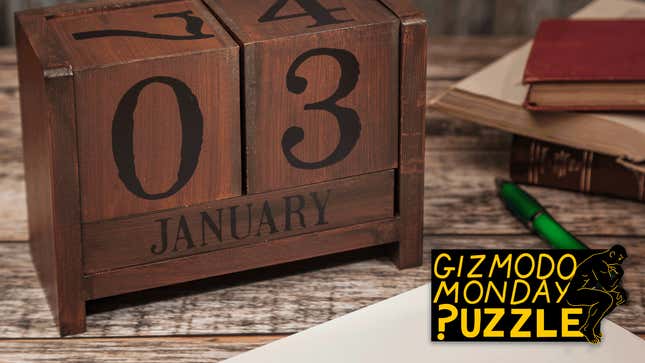
I imagine Gizmodo readers will not approve of a Luddite take, but I’m going to risk my skin and wax nostalgic for physical calendars. Do you remember Page-A-Day calendars? Each morning you’d tear a page to reveal the new date and some little reward for waking up—a comic, a vocab word, a brainteaser (!). We used to enjoy advent calendars and sexy firefighters. Today, Google Calendar and Microsoft Outlook, with their sterile and ultra-pragmatic interfaces, have relegated our fun to the obsolescent world of gag gifts. Oh, your calendar client sends automated alerts to all of a meeting’s attendees simultaneously? Sounds efficient, but did it give you a piece of chocolate?
Today’s puzzle features an under-appreciated character in the cast of calendars.
Did you miss last week’s puzzle? Check it out here, and find its solution at the bottom of today’s article. Be careful not to read too far ahead if you’re still working on that problem!
Puzzle #3: Calendar Cubes
Two cubes, each with a single digit between 0 and 9 printed on each face, can be arranged in a holder to display any day of the month as a two-digit number (e.g., 25 on Christmas or 04 on American Independence Day). How do these work? If you were tasked with designing two cubes capable of showing 01, 02, 03, …, 30, 31, how would you assign digits to their faces? This might not seem puzzling, until you set out to try. Remember that cubes only have six faces, so you have 12 total spaces to work with.
If you solve this and crave an additional challenge, how would you represent the three-letter month abbreviations (e.g. ‘jan’, ‘feb’, ‘mar’, and so on) with three cubes, in which each face contains a lowercase letter?
Solve the numeric problem first. The same trick will come in handy if you attempt the more difficult letter version.
The solution and a new puzzle will be posted here next Monday. Put it in your calendar.
Do you know a great puzzle that I should cover here? Send it to me at [email protected]
Solution to Puzzle #2: Reverse Tic-Tac-Toe
Last week, we asked you to sleuth out the past in everybody’s favorite three-in-a-row game.
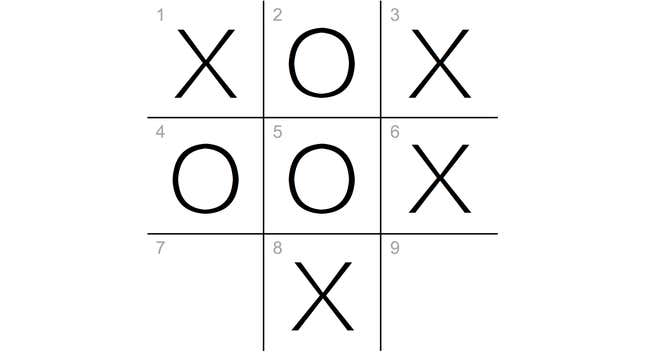
The tic-tac-toe position above was reached in a game between two flawless players, meaning neither of them ever made a move that would allow their opponent to win by force and neither of them missed an opportunity to force a win themselves. What were the last four moves played?
I’ve numbered the squares for clarity’s sake. The last four moves occurred in cells 6, 4, 8, and 2. Let’s work through the reasoning. X moved last because there are four Xs in the diagram and only three Os. So what was X’s last move? Could X have played in cell 1? Well, if that had been an option, X would have played in cell 9 instead and won the game (remember, the players play flawlessly). So X did not play in cell 1 last, nor did they play in cell 8 by the same reasoning.
The last move was either X in cell 3 or X in cell 6. How can we argue that X did not play in cell 3? Because X still could have forced a win by instead playing in cell 9! If cell 3 were empty, then cell 9 would simultaneously set up a horizontal two-in-a-row and a vertical two-in-a-row. O would be helpless to stop both on their next move. By process of elimination, we have successfully deduced the last move: X in cell 6. Retracting that move, the position looks like this with O having just played:
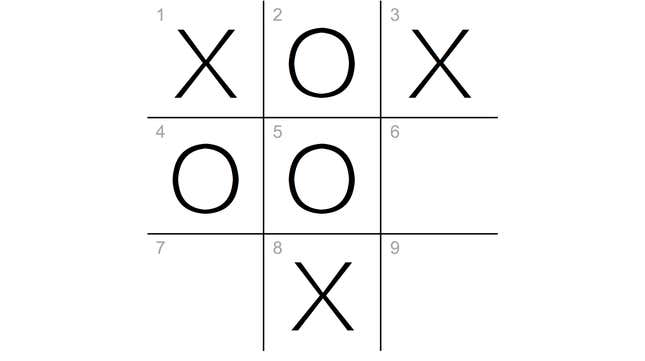
Now, what was O’s last move? It was not cell 2, because playing in cell 6 instead would have won. So O either played in cell 4 or 5. Determining which requires us to take two more steps backward. Suppose O just played in cell 5. This means the position looked like this, with X having just played:
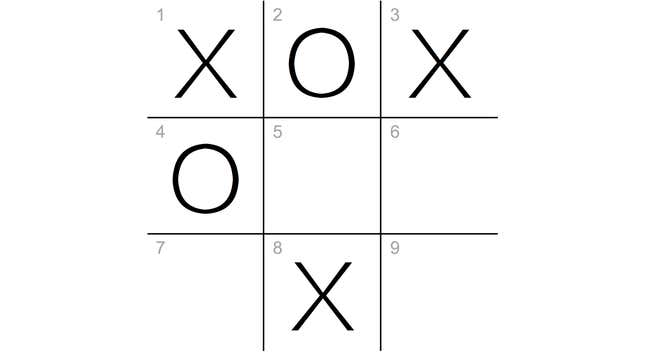
Does something seem off here? X just moved, but no matter which move of theirs we retract, X could have instead forced a win by playing in cell 9. For example, if X had just played in cell 3, playing in cell 9 instead would have set up winning threats across the diagonal and the lowest row. Feel free to check that X playing in cell 1 or 8 similarly gave up a winning opportunity in cell 9. By process of elimination, we conclude that O played in cell 4 on their third move, and the historical position looked like this:
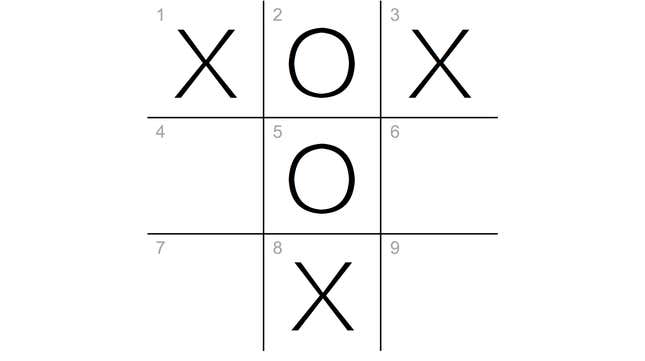
X couldn’t have just played in cell 1, because cell 9 would have forced a win. Cell 3 can’t be the answer, because cell 7 would have forced a win in that case. So X just played in cell 8. This plants us deep into antiquity, with one more move to unlock:
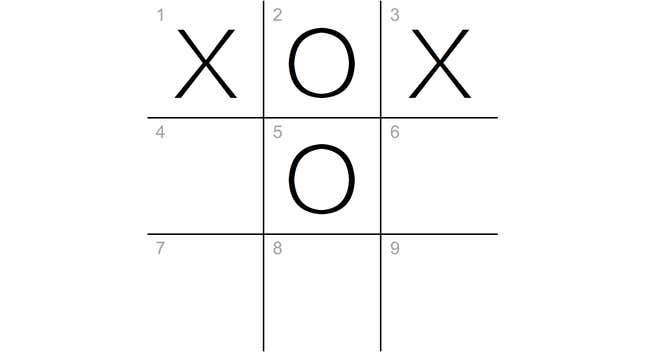
What did O just play? Suppose O just played in cell 5. Then X could have forced a win on their second move of the game by playing in cell 5 instead of in a corner! For example, if this were the position,
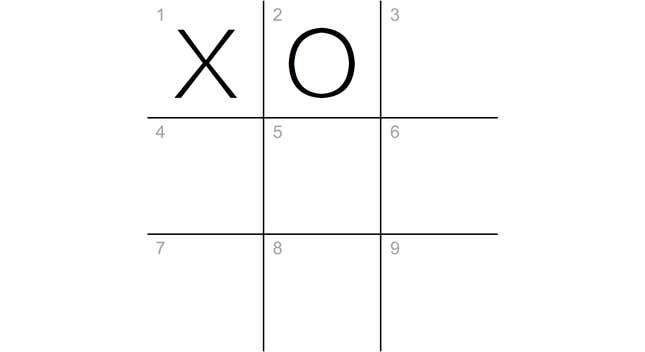
then instead of X playing in cell 3, they should play in cell 5 and the game will continue with O playing in cell 9 (to block the diagonal), and X playing in cell 7, creating an unstoppable winning threat. So O played in cell 5 on their very first move of the game, and our answer is cell 2.
We’ve now discovered the last four moves. That final deduction was a particularly tough one. Some of you may know perfect tic-tac-toe strategy, which says that if X begins the game in a corner, then O must play in the center to avoid losing. Knowing this detail could have made the final step of this puzzle easier, because X only has markings in corner cells so O, being a flawless player, must have played their first move in the center. If you solved it this way, kudos. Your days of memorizing schoolyard game strategy were not for naught… or crosses.
Whew! Detective work taxes the mind. Let us know how you did. And let us know how we’re doing! We would love to hear your feedback as we continue to shape the future of this series.

